|
PLearn 0.1
|
|
PLearn 0.1
|
Filter between two linear layers of a 2D convolutional RBM. More...
#include <RBMConv2DConnection.h>
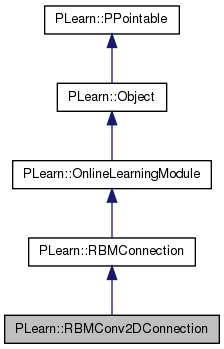
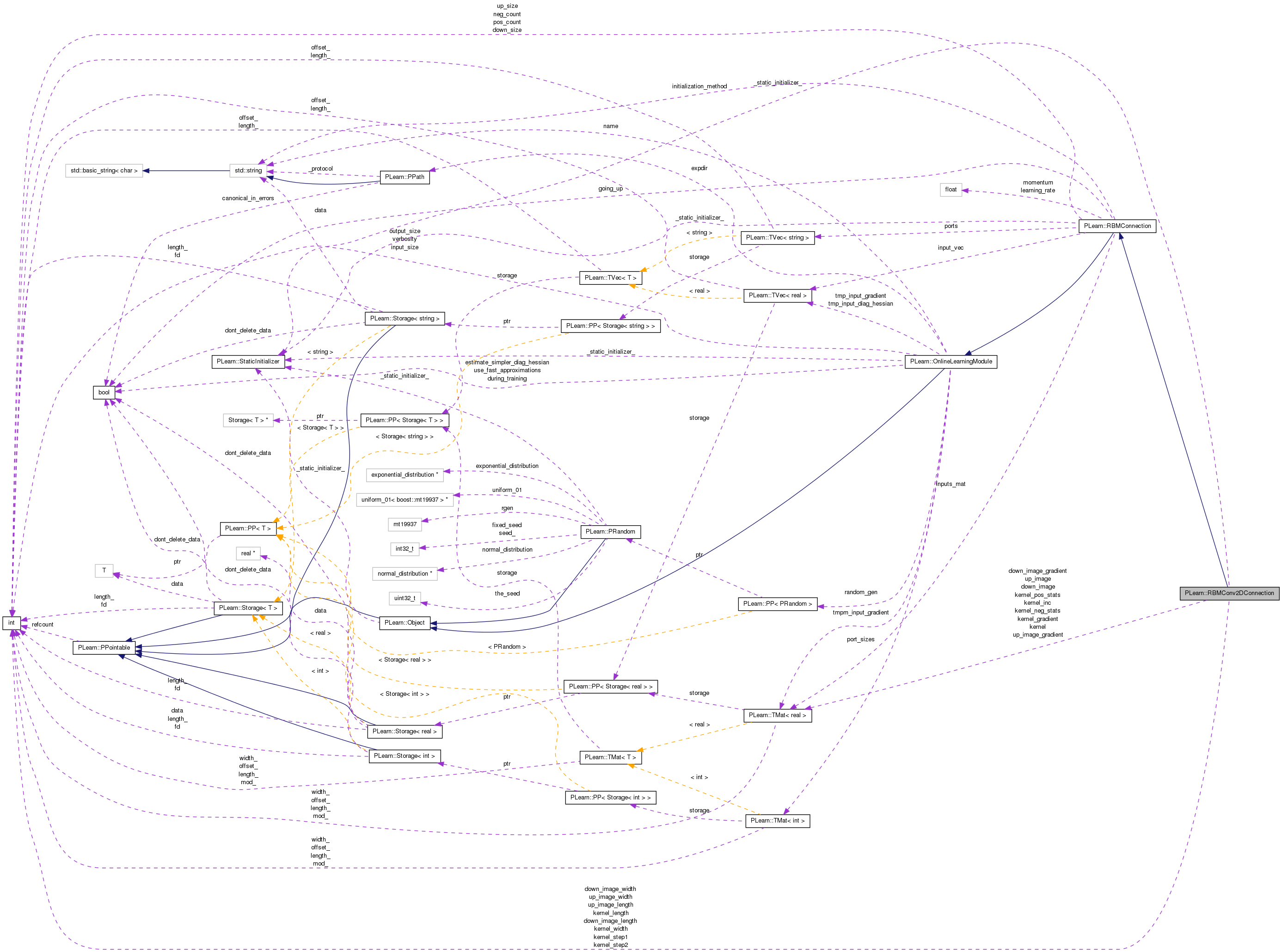
Public Member Functions | |
| RBMConv2DConnection (real the_learning_rate=0) | |
| Default constructor. | |
| virtual void | accumulatePosStats (const Vec &down_values, const Vec &up_values) |
| Accumulates positive phase statistics to *_pos_stats. | |
| virtual void | accumulatePosStats (const Mat &down_values, const Mat &up_values) |
| virtual void | accumulateNegStats (const Vec &down_values, const Vec &up_values) |
| Accumulates negative phase statistics to *_neg_stats. | |
| virtual void | accumulateNegStats (const Mat &down_values, const Mat &up_values) |
| virtual void | update () |
| Updates parameters according to contrastive divergence gradient. | |
| virtual void | update (const Vec &pos_down_values, const Vec &pos_up_values, const Vec &neg_down_values, const Vec &neg_up_values) |
| Updates parameters according to contrastive divergence gradient, not using the statistics but the explicit values passed. | |
| virtual void | update (const Mat &pos_down_values, const Mat &pos_up_values, const Mat &neg_down_values, const Mat &neg_up_values) |
| Updates parameters according to contrastive divergence gradient, not using the statistics but explicit matrix values. | |
| virtual void | clearStats () |
| Clear all information accumulated during stats. | |
| virtual void | computeProduct (int start, int length, const Vec &activations, bool accumulate=false) const |
| Computes the vectors of activation of "length" units, starting from "start", and stores them into "activations". | |
| virtual void | computeProducts (int start, int length, Mat &activations, bool accumulate=false) const |
| Same as 'computeProduct' but for mini-batches. | |
| virtual void | bpropUpdate (const Vec &input, const Vec &output, Vec &input_gradient, const Vec &output_gradient, bool accumulate=false) |
| Adapt based on the output gradient: this method should only be called just after a corresponding fprop; it should be called with the same arguments as fprop for the first two arguments (and output should not have been modified since then). | |
| virtual void | bpropUpdate (const Mat &inputs, const Mat &outputs, Mat &input_gradients, const Mat &output_gradients, bool accumulate=false) |
| SOON TO BE DEPRECATED, USE bpropAccUpdate(const TVec<Mat*>& ports_value, const TVec<Mat*>& ports_gradient) | |
| virtual void | bpropAccUpdate (const TVec< Mat * > &ports_value, const TVec< Mat * > &ports_gradient) |
| Perform a back propagation step (also updating parameters according to the provided gradient). | |
| virtual void | forget () |
| reset the parameters to the state they would be BEFORE starting training. | |
| virtual int | nParameters () const |
| optionally perform some processing after training, or after a series of fprop/bpropUpdate calls to prepare the model for truly out-of-sample operation. | |
| virtual Vec | makeParametersPointHere (const Vec &global_parameters) |
| Make the parameters data be sub-vectors of the given global_parameters. | |
| virtual string | classname () const |
| virtual OptionList & | getOptionList () const |
| virtual OptionMap & | getOptionMap () const |
| virtual RemoteMethodMap & | getRemoteMethodMap () const |
| virtual RBMConv2DConnection * | deepCopy (CopiesMap &copies) const |
| virtual void | build () |
| Post-constructor. | |
| virtual void | makeDeepCopyFromShallowCopy (CopiesMap &copies) |
| Transforms a shallow copy into a deep copy. | |
Static Public Member Functions | |
| static string | _classname_ () |
| static OptionList & | _getOptionList_ () |
| static RemoteMethodMap & | _getRemoteMethodMap_ () |
| static Object * | _new_instance_for_typemap_ () |
| static bool | _isa_ (const Object *o) |
| static void | _static_initialize_ () |
| static const PPath & | declaringFile () |
Public Attributes | |
| int | down_image_length |
| Length of the down image. | |
| int | down_image_width |
| Width of the down image. | |
| int | up_image_length |
| Length of the up image. | |
| int | up_image_width |
| Width of the up image. | |
| int | kernel_step1 |
| "Vertical" step | |
| int | kernel_step2 |
| "Horizontal" step | |
| Mat | kernel |
| Matrix containing the convolution kernel (filter) | |
| int | kernel_length |
| Length of the kernel. | |
| int | kernel_width |
| Width of the kernel. | |
| Mat | kernel_pos_stats |
| Accumulates positive contribution to the weights' gradient. | |
| Mat | kernel_neg_stats |
| Accumulates negative contribution to the weights' gradient. | |
| Mat | kernel_inc |
| Used if momentum != 0. | |
Static Public Attributes | |
| static StaticInitializer | _static_initializer_ |
Static Protected Member Functions | |
| static void | declareOptions (OptionList &ol) |
| Declares the class options. | |
Private Types | |
| typedef RBMConnection | inherited |
Private Member Functions | |
| void | build_ () |
| This does the actual building. | |
Private Attributes | |
| Mat | down_image |
| Mat | up_image |
| Mat | down_image_gradient |
| Mat | up_image_gradient |
| Mat | kernel_gradient |
Filter between two linear layers of a 2D convolutional RBM.
Definition at line 54 of file RBMConv2DConnection.h.
typedef RBMConnection PLearn::RBMConv2DConnection::inherited [private] |
Reimplemented from PLearn::RBMConnection.
Definition at line 56 of file RBMConv2DConnection.h.
| PLearn::RBMConv2DConnection::RBMConv2DConnection | ( | real | the_learning_rate = 0 | ) |
Default constructor.
Definition at line 54 of file RBMConv2DConnection.cc.
:
inherited(the_learning_rate),
down_image_length(-1),
down_image_width(-1),
up_image_length(-1),
up_image_width(-1),
kernel_step1(1),
kernel_step2(1),
kernel_length(-1),
kernel_width(-1)
{
}
| string PLearn::RBMConv2DConnection::_classname_ | ( | ) | [static] |
Reimplemented from PLearn::RBMConnection.
Definition at line 52 of file RBMConv2DConnection.cc.
| OptionList & PLearn::RBMConv2DConnection::_getOptionList_ | ( | ) | [static] |
Reimplemented from PLearn::RBMConnection.
Definition at line 52 of file RBMConv2DConnection.cc.
| RemoteMethodMap & PLearn::RBMConv2DConnection::_getRemoteMethodMap_ | ( | ) | [static] |
Reimplemented from PLearn::RBMConnection.
Definition at line 52 of file RBMConv2DConnection.cc.
Reimplemented from PLearn::RBMConnection.
Definition at line 52 of file RBMConv2DConnection.cc.
| Object * PLearn::RBMConv2DConnection::_new_instance_for_typemap_ | ( | ) | [static] |
Reimplemented from PLearn::Object.
Definition at line 52 of file RBMConv2DConnection.cc.
| StaticInitializer RBMConv2DConnection::_static_initializer_ & PLearn::RBMConv2DConnection::_static_initialize_ | ( | ) | [static] |
Reimplemented from PLearn::RBMConnection.
Definition at line 52 of file RBMConv2DConnection.cc.
| void PLearn::RBMConv2DConnection::accumulateNegStats | ( | const Vec & | down_values, |
| const Vec & | up_values | ||
| ) | [virtual] |
Accumulates negative phase statistics to *_neg_stats.
Implements PLearn::RBMConnection.
Definition at line 200 of file RBMConv2DConnection.cc.
References PLearn::convolve2Dbackprop(), down_image, down_image_length, down_image_width, kernel_neg_stats, kernel_step1, kernel_step2, PLearn::RBMConnection::neg_count, PLearn::TVec< T >::toMat(), up_image, up_image_length, and up_image_width.
{
down_image = down_values.toMat( down_image_length, down_image_width );
up_image = up_values.toMat( up_image_length, up_image_width );
/* for i=0 to up_image_length:
* for j=0 to up_image_width:
* for l=0 to kernel_length:
* for m=0 to kernel_width:
* kernel_neg_stats(l,m) +=
* down_image(step1*i+l,step2*j+m) * up_image(i,j)
*/
convolve2Dbackprop( down_image, up_image, kernel_neg_stats,
kernel_step1, kernel_step2, true );
neg_count++;
}

| virtual void PLearn::RBMConv2DConnection::accumulateNegStats | ( | const Mat & | down_values, |
| const Mat & | up_values | ||
| ) | [inline, virtual] |
Implements PLearn::RBMConnection.
Definition at line 123 of file RBMConv2DConnection.h.
References PLASSERT_MSG.
{
PLASSERT_MSG( false, "Not implemented" );
}
| virtual void PLearn::RBMConv2DConnection::accumulatePosStats | ( | const Mat & | down_values, |
| const Mat & | up_values | ||
| ) | [inline, virtual] |
Implements PLearn::RBMConnection.
Definition at line 113 of file RBMConv2DConnection.h.
References PLASSERT_MSG.
{
PLASSERT_MSG( false, "Not implemented" );
}
| void PLearn::RBMConv2DConnection::accumulatePosStats | ( | const Vec & | down_values, |
| const Vec & | up_values | ||
| ) | [virtual] |
Accumulates positive phase statistics to *_pos_stats.
Implements PLearn::RBMConnection.
Definition at line 181 of file RBMConv2DConnection.cc.
References PLearn::convolve2Dbackprop(), down_image, down_image_length, down_image_width, kernel_pos_stats, kernel_step1, kernel_step2, PLearn::RBMConnection::pos_count, PLearn::TVec< T >::toMat(), up_image, up_image_length, and up_image_width.
{
down_image = down_values.toMat( down_image_length, down_image_width );
up_image = up_values.toMat( up_image_length, up_image_width );
/* for i=0 to up_image_length:
* for j=0 to up_image_width:
* for l=0 to kernel_length:
* for m=0 to kernel_width:
* kernel_pos_stats(l,m) +=
* down_image(step1*i+l,step2*j+m) * up_image(i,j)
*/
convolve2Dbackprop( down_image, up_image, kernel_pos_stats,
kernel_step1, kernel_step2, true );
pos_count++;
}

| void PLearn::RBMConv2DConnection::bpropAccUpdate | ( | const TVec< Mat * > & | ports_value, |
| const TVec< Mat * > & | ports_gradient | ||
| ) | [virtual] |
Perform a back propagation step (also updating parameters according to the provided gradient).
The matrices in 'ports_value' must be the same as the ones given in a previous call to 'fprop' (and thus they should in particular contain the result of the fprop computation). However, they are not necessarily the same as the ones given in the LAST call to 'fprop': if there is a need to store an internal module state, this should be done using a specific port to store this state. Each Mat* pointer in the 'ports_gradient' vector can be one of:
Reimplemented from PLearn::OnlineLearningModule.
Definition at line 639 of file RBMConv2DConnection.cc.
References PLearn::backConvolve2Dbackprop(), PLearn::TMat< T >::clear(), PLearn::convolve2Dbackprop(), down_image, down_image_gradient, down_image_length, down_image_width, PLearn::RBMConnection::down_size, PLearn::TMat< T >::isEmpty(), kernel, kernel_gradient, kernel_step1, kernel_step2, PLearn::RBMConnection::learning_rate, PLearn::TMat< T >::length(), PLearn::TVec< T >::length(), PLearn::multiplyAcc(), PLearn::OnlineLearningModule::nPorts(), PLASSERT, PLCHECK_MSG, PLearn::TMat< T >::resize(), up_image, up_image_gradient, up_image_length, up_image_width, PLearn::RBMConnection::up_size, and PLearn::TMat< T >::width().
{
PLASSERT( ports_value.length() == nPorts()
&& ports_gradient.length() == nPorts() );
Mat* down = ports_value[0];
Mat* up = ports_value[1];
Mat* down_grad = ports_gradient[0];
Mat* up_grad = ports_gradient[1];
PLASSERT( down && !down->isEmpty() );
PLASSERT( up && !up->isEmpty() );
int batch_size = down->length();
PLASSERT( up->length() == batch_size );
// If we have up_grad
if( up_grad && !up_grad->isEmpty() )
{
// down_grad should not be provided
PLASSERT( !down_grad || down_grad->isEmpty() );
PLASSERT( up_grad->length() == batch_size );
PLASSERT( up_grad->width() == up_size );
// If we want down_grad
bool compute_down_grad = false;
if( down_grad && down_grad->isEmpty() )
{
PLASSERT( down_grad->width() == down_size );
down_grad->resize(batch_size, down_size);
compute_down_grad = true;
}
kernel_gradient.clear();
for (int k=0; k<batch_size; k++)
{
down_image = (*down)(k).toMat(down_image_length, down_image_width);
up_image = (*up)(k).toMat(up_image_length, up_image_width);
up_image_gradient = (*up_grad)(k)
.toMat(up_image_length, up_image_width);
if( compute_down_grad )
{
down_image_gradient = (*down_grad)(k)
.toMat(down_image_length, down_image_width);
convolve2Dbackprop(down_image, kernel,
up_image_gradient, down_image_gradient,
kernel_gradient,
kernel_step1, kernel_step2, true);
}
else
convolve2Dbackprop(down_image, up_image_gradient,
kernel_gradient,
kernel_step1, kernel_step2, true);
}
// kernel -= learning_rate/n * kernel_gradient
multiplyAcc(kernel, kernel_gradient, -learning_rate/batch_size);
}
else if( down_grad && !down_grad->isEmpty() )
{
PLASSERT( down_grad->length() == batch_size );
PLASSERT( down_grad->width() == down_size );
// If we want up_grad
bool compute_up_grad = false;
if( up_grad && up_grad->isEmpty() )
{
PLASSERT( up_grad->width() == up_size );
up_grad->resize(batch_size, up_size);
compute_up_grad = true;
}
kernel_gradient.clear();
for (int k=0; k<batch_size; k++)
{
down_image = (*down)(k).toMat(down_image_length, down_image_width);
up_image = (*up)(k).toMat(up_image_length, up_image_width);
down_image_gradient = (*down_grad)(k)
.toMat(down_image_length, down_image_width);
if( compute_up_grad )
{
up_image_gradient = (*up_grad)(k)
.toMat(up_image_length, up_image_width);
backConvolve2Dbackprop(kernel, up_image, up_image_gradient,
down_image_gradient, kernel_gradient,
kernel_step1, kernel_step2, true);
}
else
backConvolve2Dbackprop(up_image, down_image_gradient,
kernel_gradient,
kernel_step1, kernel_step2, true);
}
// kernel -= learning_rate/n * kernel_gradient
multiplyAcc(kernel, kernel_gradient, -learning_rate/batch_size);
}
else
PLCHECK_MSG( false,
"Unknown port configuration" );
}
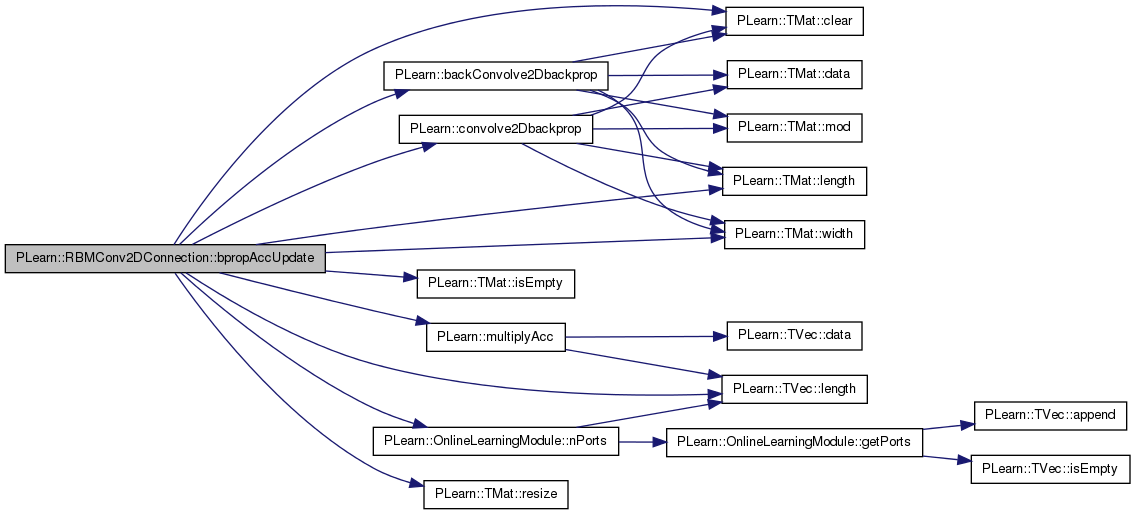
| void PLearn::RBMConv2DConnection::bpropUpdate | ( | const Vec & | input, |
| const Vec & | output, | ||
| Vec & | input_gradient, | ||
| const Vec & | output_gradient, | ||
| bool | accumulate = false |
||
| ) | [virtual] |
Adapt based on the output gradient: this method should only be called just after a corresponding fprop; it should be called with the same arguments as fprop for the first two arguments (and output should not have been modified since then).
this version allows to obtain the input gradient as well
Since sub-classes are supposed to learn ONLINE, the object is 'ready-to-be-used' just after any bpropUpdate. N.B. A DEFAULT IMPLEMENTATION IS PROVIDED IN THE SUPER-CLASS, WHICH JUST CALLS bpropUpdate(input, output, input_gradient, output_gradient) AND IGNORES INPUT GRADIENT. this version allows to obtain the input gradient as well N.B. THE DEFAULT IMPLEMENTATION IN SUPER-CLASS JUST RAISES A PLERROR.
Reimplemented from PLearn::OnlineLearningModule.
Definition at line 556 of file RBMConv2DConnection.cc.
References PLearn::convolve2Dbackprop(), down_image, down_image_gradient, down_image_length, down_image_width, PLearn::RBMConnection::down_size, kernel, kernel_gradient, kernel_step1, kernel_step2, PLearn::RBMConnection::learning_rate, PLearn::multiplyAcc(), PLASSERT, PLASSERT_MSG, PLearn::TVec< T >::resize(), PLearn::TVec< T >::size(), PLearn::TVec< T >::toMat(), up_image, up_image_gradient, up_image_length, up_image_width, and PLearn::RBMConnection::up_size.
{
PLASSERT( input.size() == down_size );
PLASSERT( output.size() == up_size );
PLASSERT( output_gradient.size() == up_size );
if( accumulate )
{
PLASSERT_MSG( input_gradient.size() == down_size,
"Cannot resize input_gradient AND accumulate into it" );
}
else
input_gradient.resize( down_size );
down_image = input.toMat( down_image_length, down_image_width );
up_image = output.toMat( up_image_length, up_image_width );
down_image_gradient = input_gradient.toMat( down_image_length,
down_image_width );
up_image_gradient = output_gradient.toMat( up_image_length,
up_image_width );
// update input_gradient and kernel_gradient
convolve2Dbackprop( down_image, kernel,
up_image_gradient, down_image_gradient,
kernel_gradient,
kernel_step1, kernel_step2, accumulate );
// kernel -= learning_rate * kernel_gradient
multiplyAcc( kernel, kernel_gradient, -learning_rate );
}
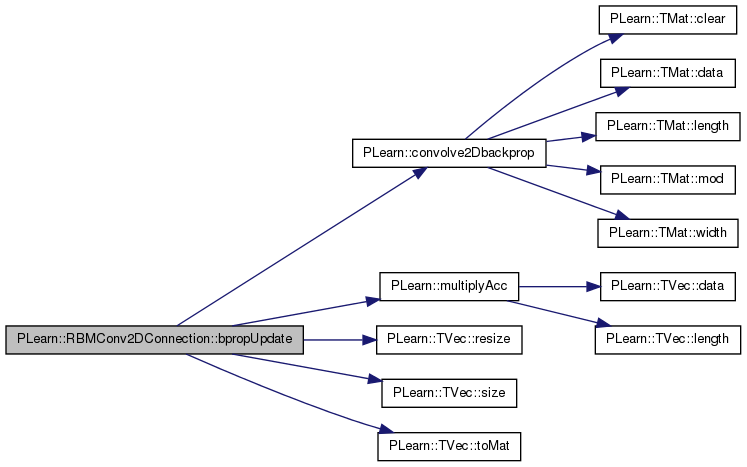
| void PLearn::RBMConv2DConnection::bpropUpdate | ( | const Mat & | inputs, |
| const Mat & | outputs, | ||
| Mat & | input_gradients, | ||
| const Mat & | output_gradients, | ||
| bool | accumulate = false |
||
| ) | [virtual] |
SOON TO BE DEPRECATED, USE bpropAccUpdate(const TVec<Mat*>& ports_value, const TVec<Mat*>& ports_gradient)
Reimplemented from PLearn::OnlineLearningModule.
Definition at line 590 of file RBMConv2DConnection.cc.
References PLearn::TMat< T >::clear(), PLearn::convolve2Dbackprop(), down_image, down_image_gradient, down_image_length, down_image_width, PLearn::RBMConnection::down_size, kernel, kernel_gradient, kernel_step1, kernel_step2, PLearn::RBMConnection::learning_rate, PLearn::TMat< T >::length(), PLearn::multiplyAcc(), PLASSERT, PLASSERT_MSG, PLearn::TMat< T >::resize(), up_image, up_image_gradient, up_image_length, up_image_width, PLearn::RBMConnection::up_size, and PLearn::TMat< T >::width().
{
PLASSERT( inputs.width() == down_size );
PLASSERT( outputs.width() == up_size );
PLASSERT( output_gradients.width() == up_size );
int batch_size = inputs.length();
PLASSERT( outputs.length() == batch_size );
PLASSERT( output_gradients.length() == batch_size );
if( accumulate )
{
PLASSERT_MSG( input_gradients.width() == down_size &&
input_gradients.length() == batch_size,
"Cannot resize input_gradient AND accumulate into it" );
}
else
{
input_gradients.resize(batch_size, down_size);
input_gradients.clear();
}
kernel_gradient.clear();
for( int k=0; k<batch_size; k++ )
{
down_image = inputs(k).toMat( down_image_length, down_image_width );
up_image = outputs(k).toMat( up_image_length, up_image_width );
down_image_gradient = input_gradients(k)
.toMat( down_image_length, down_image_width );
up_image_gradient = output_gradients(k)
.toMat( up_image_length, up_image_width );
// update input_gradient and kernel_gradient
convolve2Dbackprop( down_image, kernel,
up_image_gradient, down_image_gradient,
kernel_gradient,
kernel_step1, kernel_step2, true );
}
// kernel -= learning_rate/n * kernel_gradient
multiplyAcc( kernel, kernel_gradient, -learning_rate/batch_size );
}
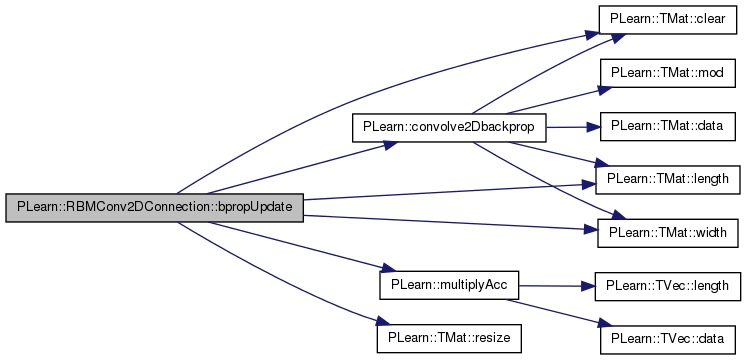
| void PLearn::RBMConv2DConnection::build | ( | ) | [virtual] |
Post-constructor.
The normal implementation should call simply inherited::build(), then this class's build_(). This method should be callable again at later times, after modifying some option fields to change the "architecture" of the object.
Reimplemented from PLearn::RBMConnection.
Definition at line 159 of file RBMConv2DConnection.cc.
References PLearn::RBMConnection::build(), and build_().
{
inherited::build();
build_();
}
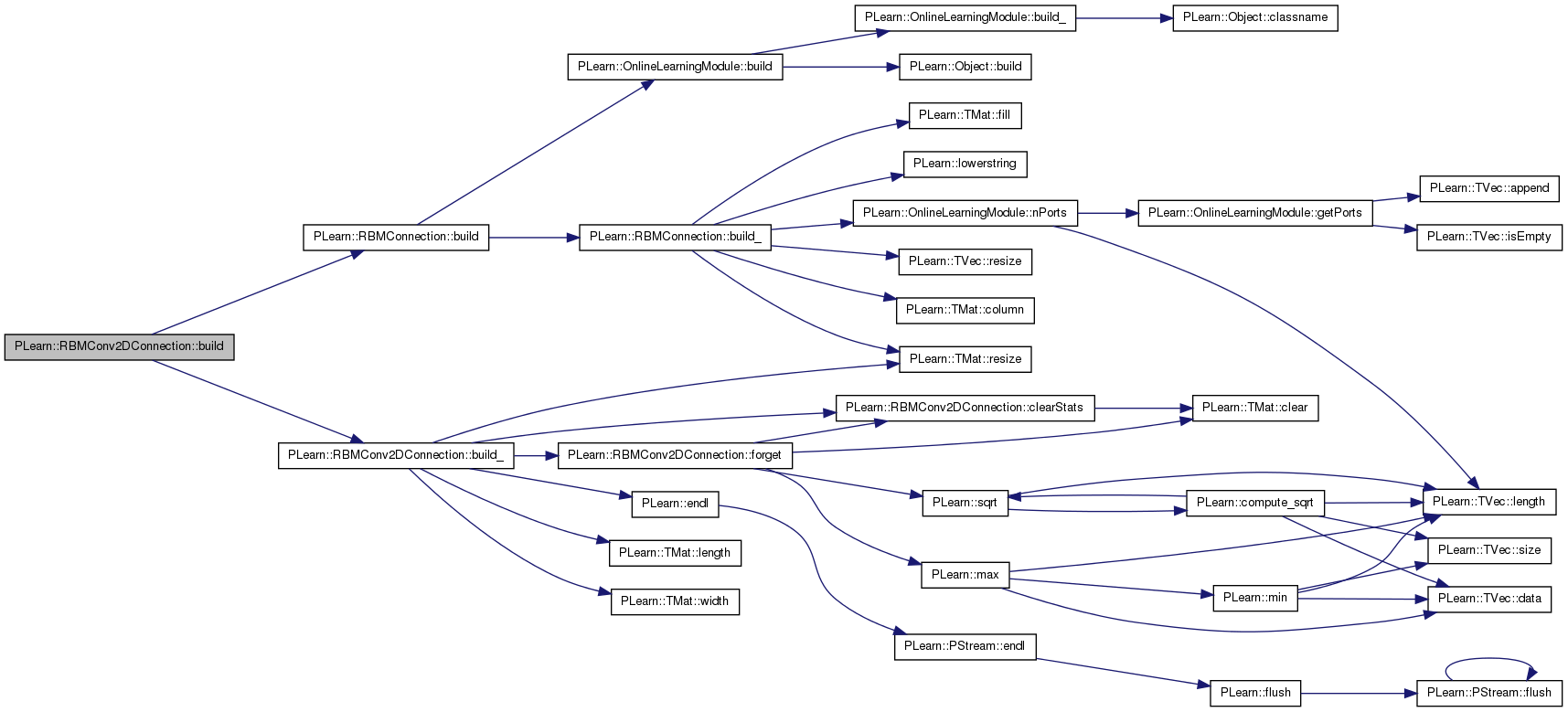
| void PLearn::RBMConv2DConnection::build_ | ( | ) | [private] |
This does the actual building.
Reimplemented from PLearn::RBMConnection.
Definition at line 115 of file RBMConv2DConnection.cc.
References clearStats(), down_image_length, down_image_width, PLearn::RBMConnection::down_size, PLearn::endl(), forget(), kernel, kernel_gradient, kernel_inc, kernel_length, kernel_neg_stats, kernel_pos_stats, kernel_step1, kernel_step2, kernel_width, PLearn::TMat< T >::length(), PLearn::RBMConnection::momentum, PLearn::OnlineLearningModule::output_size, PLASSERT, PLearn::TMat< T >::resize(), up_image_length, up_image_width, PLearn::RBMConnection::up_size, and PLearn::TMat< T >::width().
Referenced by build().
{
MODULE_LOG << "build_() called" << endl;
down_size = down_image_length * down_image_width;
up_size = up_image_length * up_image_width;
PLASSERT( down_image_length > 0 );
PLASSERT( down_image_width > 0 );
PLASSERT( down_image_length * down_image_width == down_size );
PLASSERT( up_image_length > 0 );
PLASSERT( up_image_width > 0 );
PLASSERT( up_image_length * up_image_width == up_size );
PLASSERT( kernel_step1 > 0 );
PLASSERT( kernel_step2 > 0 );
kernel_length = down_image_length - kernel_step1 * (up_image_length-1);
PLASSERT( kernel_length > 0 );
kernel_width = down_image_width - kernel_step2 * (up_image_width-1);
PLASSERT( kernel_width > 0 );
output_size = 0;
bool needs_forget = false; // do we need to reinitialize the parameters?
if( kernel.length() != kernel_length ||
kernel.width() != kernel_width )
{
kernel.resize( kernel_length, kernel_width );
needs_forget = true;
}
kernel_pos_stats.resize( kernel_length, kernel_width );
kernel_neg_stats.resize( kernel_length, kernel_width );
kernel_gradient.resize( kernel_length, kernel_width );
if( momentum != 0. )
kernel_inc.resize( kernel_length, kernel_width );
if( needs_forget )
forget();
clearStats();
}


| string PLearn::RBMConv2DConnection::classname | ( | ) | const [virtual] |
Reimplemented from PLearn::Object.
Definition at line 52 of file RBMConv2DConnection.cc.
| void PLearn::RBMConv2DConnection::clearStats | ( | ) | [virtual] |
Clear all information accumulated during stats.
Implements PLearn::RBMConnection.
Definition at line 428 of file RBMConv2DConnection.cc.
References PLearn::TMat< T >::clear(), kernel_neg_stats, kernel_pos_stats, PLearn::RBMConnection::neg_count, and PLearn::RBMConnection::pos_count.
Referenced by build_(), forget(), and update().
{
kernel_pos_stats.clear();
kernel_neg_stats.clear();
pos_count = 0;
neg_count = 0;
}


| void PLearn::RBMConv2DConnection::computeProduct | ( | int | start, |
| int | length, | ||
| const Vec & | activations, | ||
| bool | accumulate = false |
||
| ) | const [virtual] |
Computes the vectors of activation of "length" units, starting from "start", and stores them into "activations".
"start" indexes an up unit if "going_up", else a down unit.
Implements PLearn::RBMConnection.
Definition at line 438 of file RBMConv2DConnection.cc.
References PLearn::backConvolve2D(), PLearn::convolve2D(), PLearn::TVec< T >::length(), m, PLASSERT, PLearn::TVec< T >::subVec(), and PLearn::TVec< T >::toMat().
{
// Unoptimized way, that computes all the activations and return a subvec
PLASSERT( activations.length() == length );
if( going_up )
{
PLASSERT( start+length <= up_size );
down_image = input_vec.toMat( down_image_length, down_image_width );
// special cases:
if( length == 1 )
{
real act = 0;
real* k = kernel.data();
real* di = down_image.data()
+ kernel_step1*(start / down_image_width)
+ kernel_step2*(start % down_image_width);
for( int l=0; l<kernel_length; l++, di+=down_image_width )
for( int m=0; m<kernel_width; m++ )
act += di[m] * k[m];
if( accumulate )
activations[0] += act;
else
activations[0] = act;
}
else if( start == 0 && length == up_size )
{
up_image = activations.toMat( up_image_length, up_image_width );
convolve2D( down_image, kernel, up_image,
kernel_step1, kernel_step2, accumulate );
}
else
{
up_image = Mat( up_image_length, up_image_width );
convolve2D( down_image, kernel, up_image,
kernel_step1, kernel_step2, false );
if( accumulate )
activations += up_image.toVec().subVec( start, length );
else
activations << up_image.toVec().subVec( start, length );
}
}
else
{
PLASSERT( start+length <= down_size );
up_image = input_vec.toMat( up_image_length, up_image_width );
// special cases
if( start == 0 && length == down_size )
{
down_image = activations.toMat( down_image_length,
down_image_width );
backConvolve2D( down_image, kernel, up_image,
kernel_step1, kernel_step2, accumulate );
}
else
{
down_image = Mat( down_image_length, down_image_width );
backConvolve2D( down_image, kernel, up_image,
kernel_step1, kernel_step2, false );
if( accumulate )
activations += down_image.toVec().subVec( start, length );
else
activations << down_image.toVec().subVec( start, length );
}
}
}
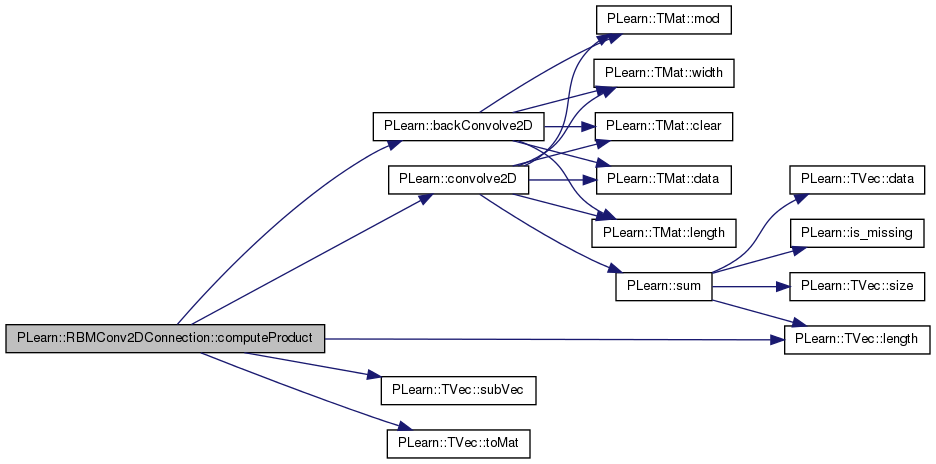
| void PLearn::RBMConv2DConnection::computeProducts | ( | int | start, |
| int | length, | ||
| Mat & | activations, | ||
| bool | accumulate = false |
||
| ) | const [virtual] |
Same as 'computeProduct' but for mini-batches.
Implements PLearn::RBMConnection.
Definition at line 506 of file RBMConv2DConnection.cc.
References PLearn::backConvolve2D(), PLearn::convolve2D(), down_image, down_image_length, down_image_width, PLearn::RBMConnection::down_size, PLearn::RBMConnection::going_up, PLearn::RBMConnection::inputs_mat, kernel, kernel_step1, kernel_step2, PLearn::TMat< T >::length(), PLASSERT, PLCHECK_MSG, PLearn::TMat< T >::resize(), up_image, up_image_length, up_image_width, PLearn::RBMConnection::up_size, and PLearn::TMat< T >::width().
{
PLASSERT( activations.width() == length );
int batch_size = inputs_mat.length();
activations.resize( batch_size, length);
if( going_up )
{
PLASSERT( start+length <= up_size );
// usual case
if( start == 0 && length == up_size )
for( int k=0; k<batch_size; k++ )
{
up_image = activations(k)
.toMat(up_image_length, up_image_width);
down_image = inputs_mat(k)
.toMat(down_image_length, down_image_width);
convolve2D(down_image, kernel, up_image,
kernel_step1, kernel_step2, accumulate);
}
else
PLCHECK_MSG(false,
"Unusual case of use (start!=0 or length!=up_size)\n"
"not implemented yet.");
}
else
{
PLASSERT( start+length <= down_size );
// usual case
if( start == 0 && length == down_size )
for( int k=0; k<batch_size; k++ )
{
up_image = inputs_mat(k)
.toMat(up_image_length, up_image_width);
down_image = activations(k)
.toMat(down_image_length, down_image_width);
backConvolve2D(down_image, kernel, up_image,
kernel_step1, kernel_step2, accumulate);
}
else
PLCHECK_MSG(false,
"Unusual case of use (start!=0 or length!=down_size)\n"
"not implemented yet.");
}
}
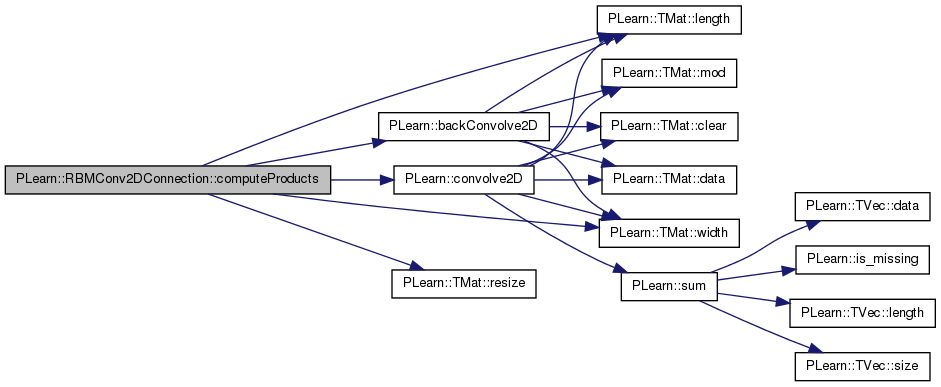
| void PLearn::RBMConv2DConnection::declareOptions | ( | OptionList & | ol | ) | [static, protected] |
Declares the class options.
Reimplemented from PLearn::RBMConnection.
Definition at line 67 of file RBMConv2DConnection.cc.
References PLearn::OptionBase::buildoption, PLearn::declareOption(), PLearn::RBMConnection::declareOptions(), down_image_length, down_image_width, PLearn::RBMConnection::down_size, kernel, kernel_step1, kernel_step2, PLearn::OptionBase::learntoption, PLearn::redeclareOption(), up_image_length, up_image_width, and PLearn::RBMConnection::up_size.
{
declareOption(ol, "down_image_length",
&RBMConv2DConnection::down_image_length,
OptionBase::buildoption,
"Length of the down image");
declareOption(ol, "down_image_width",
&RBMConv2DConnection::down_image_width,
OptionBase::buildoption,
"Width of the down image");
declareOption(ol, "up_image_length",
&RBMConv2DConnection::up_image_length,
OptionBase::buildoption,
"Length of the up image");
declareOption(ol, "up_image_width",
&RBMConv2DConnection::up_image_width,
OptionBase::buildoption,
"Width of the up image");
declareOption(ol, "kernel_step1", &RBMConv2DConnection::kernel_step1,
OptionBase::buildoption,
"\"Vertical\" step of the convolution");
declareOption(ol, "kernel_step2", &RBMConv2DConnection::kernel_step2,
OptionBase::buildoption,
"\"Horizontal\" step of the convolution");
declareOption(ol, "kernel", &RBMConv2DConnection::kernel,
OptionBase::learntoption,
"Matrix containing the convolution kernel (filter)");
// Now call the parent class' declareOptions
inherited::declareOptions(ol);
redeclareOption(ol, "down_size",
&RBMConv2DConnection::down_size,
OptionBase::learntoption,
"Equals to down_image_length × down_image_width");
redeclareOption(ol, "up_size",
&RBMConv2DConnection::up_size,
OptionBase::learntoption,
"Equals to up_image_length × up_image_width");
}

| static const PPath& PLearn::RBMConv2DConnection::declaringFile | ( | ) | [inline, static] |
Reimplemented from PLearn::RBMConnection.
Definition at line 210 of file RBMConv2DConnection.h.
:
//##### Protected Member Functions ######################################
| RBMConv2DConnection * PLearn::RBMConv2DConnection::deepCopy | ( | CopiesMap & | copies | ) | const [virtual] |
Reimplemented from PLearn::RBMConnection.
Definition at line 52 of file RBMConv2DConnection.cc.
| void PLearn::RBMConv2DConnection::forget | ( | ) | [virtual] |
reset the parameters to the state they would be BEFORE starting training.
Note that this method is necessarily called from build().
Implements PLearn::OnlineLearningModule.
Definition at line 744 of file RBMConv2DConnection.cc.
References PLearn::TMat< T >::clear(), clearStats(), d, PLearn::RBMConnection::initialization_method, kernel, kernel_length, kernel_width, PLearn::max(), PLWARNING, PLearn::OnlineLearningModule::random_gen, and PLearn::sqrt().
Referenced by build_().
{
clearStats();
if( initialization_method == "zero" )
kernel.clear();
else
{
if( !random_gen )
{
PLWARNING( "RBMConv2DConnection: cannot forget() without"
" random_gen" );
return;
}
real d = 1. / max( kernel_length, kernel_width );
if( initialization_method == "uniform_sqrt" )
d = sqrt( d );
random_gen->fill_random_uniform( kernel, -d, d );
}
}


| OptionList & PLearn::RBMConv2DConnection::getOptionList | ( | ) | const [virtual] |
Reimplemented from PLearn::Object.
Definition at line 52 of file RBMConv2DConnection.cc.
| OptionMap & PLearn::RBMConv2DConnection::getOptionMap | ( | ) | const [virtual] |
Reimplemented from PLearn::Object.
Definition at line 52 of file RBMConv2DConnection.cc.
| RemoteMethodMap & PLearn::RBMConv2DConnection::getRemoteMethodMap | ( | ) | const [virtual] |
Reimplemented from PLearn::Object.
Definition at line 52 of file RBMConv2DConnection.cc.
| void PLearn::RBMConv2DConnection::makeDeepCopyFromShallowCopy | ( | CopiesMap & | copies | ) | [virtual] |
Transforms a shallow copy into a deep copy.
Reimplemented from PLearn::RBMConnection.
Definition at line 166 of file RBMConv2DConnection.cc.
References PLearn::deepCopyField(), down_image, down_image_gradient, kernel, kernel_gradient, kernel_inc, kernel_neg_stats, kernel_pos_stats, PLearn::RBMConnection::makeDeepCopyFromShallowCopy(), up_image, and up_image_gradient.
{
inherited::makeDeepCopyFromShallowCopy(copies);
deepCopyField(kernel, copies);
deepCopyField(kernel_pos_stats, copies);
deepCopyField(kernel_neg_stats, copies);
deepCopyField(kernel_gradient, copies);
deepCopyField(kernel_inc, copies);
deepCopyField(down_image, copies);
deepCopyField(up_image, copies);
deepCopyField(down_image_gradient, copies);
deepCopyField(up_image_gradient, copies);
}

Make the parameters data be sub-vectors of the given global_parameters.
The argument should have size >= nParameters. The result is a Vec that starts just after this object's parameters end, i.e. result = global_parameters.subVec(nParameters(),global_parameters.size()-nParameters()); This allows to easily chain calls of this method on multiple RBMParameters.
Implements PLearn::RBMConnection.
Definition at line 788 of file RBMConv2DConnection.cc.
References PLearn::TVec< T >::data(), kernel, m, PLearn::TMat< T >::makeSharedValue(), n, PLERROR, PLearn::TVec< T >::size(), PLearn::TMat< T >::size(), and PLearn::TVec< T >::subVec().
{
int n=kernel.size();
int m = global_parameters.size();
if (m<n)
PLERROR("RBMConv2DConnection::makeParametersPointHere: argument has length %d, should be longer than nParameters()=%d",m,n);
real* p = global_parameters.data();
kernel.makeSharedValue(p,n);
return global_parameters.subVec(n,m-n);
}
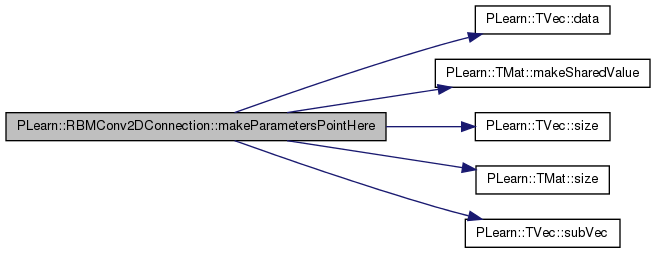
| int PLearn::RBMConv2DConnection::nParameters | ( | ) | const [virtual] |
optionally perform some processing after training, or after a series of fprop/bpropUpdate calls to prepare the model for truly out-of-sample operation.
return the number of parameters
THE DEFAULT IMPLEMENTATION PROVIDED IN THE SUPER-CLASS DOES NOT DO ANYTHING. return the number of parameters
Implements PLearn::RBMConnection.
Definition at line 778 of file RBMConv2DConnection.cc.
References kernel, and PLearn::TMat< T >::size().
{
return kernel.size();
}

| void PLearn::RBMConv2DConnection::update | ( | const Vec & | pos_down_values, |
| const Vec & | pos_up_values, | ||
| const Vec & | neg_down_values, | ||
| const Vec & | neg_up_values | ||
| ) | [virtual] |
Updates parameters according to contrastive divergence gradient, not using the statistics but the explicit values passed.
Reimplemented from PLearn::RBMConnection.
Definition at line 268 of file RBMConv2DConnection.cc.
References PLearn::TMat< T >::data(), PLearn::TVec< T >::data(), down_image_length, down_image_width, PLearn::RBMConnection::down_size, i, j, kernel, kernel_inc, kernel_length, kernel_step1, kernel_step2, kernel_width, PLearn::RBMConnection::learning_rate, PLearn::TVec< T >::length(), m, PLearn::TMat< T >::mod(), PLearn::RBMConnection::momentum, PLearn::multiplyAcc(), PLASSERT, PLearn::TMat< T >::resize(), up_image_length, up_image_width, and PLearn::RBMConnection::up_size.
{
PLASSERT( pos_up_values.length() == up_size );
PLASSERT( neg_up_values.length() == up_size );
PLASSERT( pos_down_values.length() == down_size );
PLASSERT( neg_down_values.length() == down_size );
/* for i=0 to up_image_length:
* for j=0 to up_image_width:
* for l=0 to kernel_length:
* for m=0 to kernel_width:
* kernel_neg_stats(l,m) += learning_rate *
* ( pos_down_image(step1*i+l,step2*j+m) * pos_up_image(i,j)
* - neg_down_image(step1*i+l,step2*j+m) * neg_up_image(i,j) )
*/
real* puv = pos_up_values.data();
real* nuv = neg_up_values.data();
real* pdv = pos_down_values.data();
real* ndv = neg_down_values.data();
int k_mod = kernel.mod();
if( momentum == 0. )
{
for( int i=0; i<up_image_length; i++,
puv+=up_image_width,
nuv+=up_image_width,
pdv+=kernel_step1*down_image_width,
ndv+=kernel_step1*down_image_width )
{
// copies to iterate over columns
real* pdv1 = pdv;
real* ndv1 = ndv;
for( int j=0; j<up_image_width; j++,
pdv1+=kernel_step2,
ndv1+=kernel_step2 )
{
real* k = kernel.data();
real* pdv2 = pdv1; // copy to iterate over sub-rows
real* ndv2 = ndv1;
real puv_ij = puv[j];
real nuv_ij = nuv[j];
for( int l=0; l<kernel_length; l++, k+=k_mod,
pdv2+=down_image_width,
ndv2+=down_image_width )
for( int m=0; m<kernel_width; m++ )
k[m] += learning_rate *
(pdv2[m] * puv_ij - ndv2[m] * nuv_ij);
}
}
}
else
{
// ensure that weights_inc has the right size
kernel_inc.resize( kernel_length, kernel_width );
kernel_inc *= momentum;
int kinc_mod = kernel_inc.mod();
for( int i=0; i<down_image_length; i++,
puv+=up_image_width,
nuv+=up_image_width,
pdv+=kernel_step1*down_image_width,
ndv+=kernel_step1*down_image_width )
{
// copies to iterate over columns
real* pdv1 = pdv;
real* ndv1 = ndv;
for( int j=0; j<down_image_width; j++,
pdv1+=kernel_step2,
ndv1+=kernel_step2 )
{
real* kinc = kernel_inc.data();
real* pdv2 = pdv1; // copy to iterate over sub-rows
real* ndv2 = ndv1;
real puv_ij = puv[j];
real nuv_ij = nuv[j];
for( int l=0; l<kernel_length; l++, kinc+=kinc_mod,
pdv2+=down_image_width,
ndv2+=down_image_width )
for( int m=0; m<kernel_width; m++ )
kinc[m] += pdv2[m] * puv_ij - ndv2[m] * nuv_ij;
}
}
multiplyAcc( kernel, kernel_inc, learning_rate );
}
}
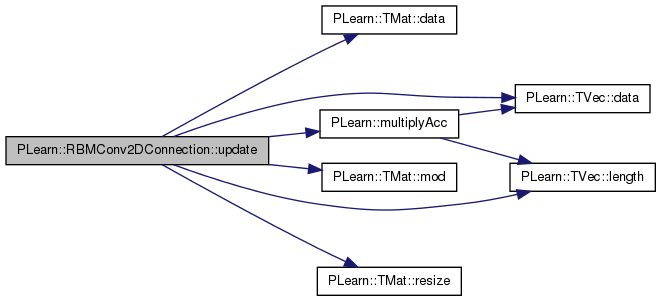
| void PLearn::RBMConv2DConnection::update | ( | const Mat & | pos_down_values, |
| const Mat & | pos_up_values, | ||
| const Mat & | neg_down_values, | ||
| const Mat & | neg_up_values | ||
| ) | [virtual] |
Updates parameters according to contrastive divergence gradient, not using the statistics but explicit matrix values.
Reimplemented from PLearn::RBMConnection.
Definition at line 358 of file RBMConv2DConnection.cc.
References b, PLearn::TMat< T >::data(), down_image_width, PLearn::RBMConnection::down_size, i, j, kernel, kernel_length, kernel_step1, kernel_step2, kernel_width, PLearn::RBMConnection::learning_rate, PLearn::TMat< T >::length(), m, PLearn::TMat< T >::mod(), PLearn::RBMConnection::momentum, PLASSERT, PLCHECK_MSG, up_image_length, up_image_width, PLearn::RBMConnection::up_size, and PLearn::TMat< T >::width().
{
PLASSERT( pos_up_values.width() == up_size );
PLASSERT( neg_up_values.width() == up_size );
PLASSERT( pos_down_values.width() == down_size );
PLASSERT( neg_down_values.width() == down_size );
int batch_size = pos_down_values.length();
PLASSERT( pos_up_values.length() == batch_size );
PLASSERT( neg_down_values.length() == batch_size );
PLASSERT( neg_up_values.length() == batch_size );
real norm_lr = learning_rate / batch_size;
/* for i=0 to up_image_length:
* for j=0 to up_image_width:
* for l=0 to kernel_length:
* for m=0 to kernel_width:
* kernel_neg_stats(l,m) += learning_rate *
* ( pos_down_image(step1*i+l,step2*j+m) * pos_up_image(i,j)
* - neg_down_image(step1*i+l,step2*j+m) * neg_up_image(i,j) )
*/
if( momentum == 0. )
{
for( int b=0; b<batch_size; b++ )
{
real* puv = pos_up_values(b).data();
real* nuv = neg_up_values(b).data();
real* pdv = pos_down_values(b).data();
real* ndv = neg_down_values(b).data();
int k_mod = kernel.mod();
for( int i=0; i<up_image_length;
i++,
puv+=up_image_width,
nuv+=up_image_width,
pdv+=kernel_step1*down_image_width,
ndv+=kernel_step1*down_image_width )
{
// copies to iterate over columns
real* pdv1 = pdv;
real* ndv1 = ndv;
for( int j=0; j<up_image_width; j++,
pdv1+=kernel_step2,
ndv1+=kernel_step2 )
{
real* k = kernel.data();
real* pdv2 = pdv1; // copy to iterate over sub-rows
real* ndv2 = ndv1;
real puv_ij = puv[j];
real nuv_ij = nuv[j];
for( int l=0; l<kernel_length; l++, k+=k_mod,
pdv2+=down_image_width,
ndv2+=down_image_width )
for( int m=0; m<kernel_width; m++ )
k[m] += norm_lr *
(pdv2[m] * puv_ij - ndv2[m] * nuv_ij);
}
}
}
}
else
PLCHECK_MSG(false,
"mini-batch and momentum don't work together yet");
}
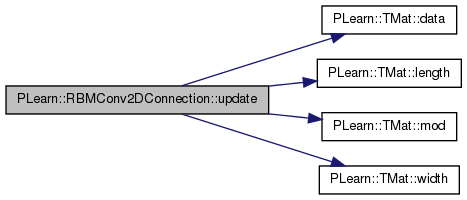
| void PLearn::RBMConv2DConnection::update | ( | ) | [virtual] |
Updates parameters according to contrastive divergence gradient.
Implements PLearn::RBMConnection.
Definition at line 218 of file RBMConv2DConnection.cc.
References clearStats(), PLearn::TMat< T >::data(), i, j, kernel, kernel_inc, kernel_length, kernel_neg_stats, kernel_pos_stats, kernel_width, PLearn::RBMConnection::learning_rate, PLearn::TMat< T >::mod(), PLearn::RBMConnection::momentum, PLearn::RBMConnection::neg_count, PLearn::RBMConnection::pos_count, and PLearn::TMat< T >::resize().
{
// updates parameters
// kernel += learning_rate * (kernel_pos_stats/pos_count
// - kernel_neg_stats/neg_count)
real pos_factor = learning_rate / pos_count;
real neg_factor = -learning_rate / neg_count;
real* k_i = kernel.data();
real* kps_i = kernel_pos_stats.data();
real* kns_i = kernel_neg_stats.data();
int k_mod = kernel.mod();
int kps_mod = kernel_pos_stats.mod();
int kns_mod = kernel_neg_stats.mod();
if( momentum == 0. )
{
// no need to use weights_inc
for( int i=0 ; i<kernel_length ; i++, k_i+=k_mod,
kps_i+=kps_mod, kns_i+=kns_mod )
for( int j=0 ; j<kernel_width ; j++ )
k_i[j] += pos_factor * kps_i[j] + neg_factor * kns_i[j];
}
else
{
// ensure that weights_inc has the right size
kernel_inc.resize( kernel_length, kernel_width );
// The update rule becomes:
// kernel_inc = momentum * kernel_inc
// - learning_rate * (kernel_pos_stats/pos_count
// - kernel_neg_stats/neg_count);
// kernel += kernel_inc;
real* kinc_i = kernel_inc.data();
int kinc_mod = kernel_inc.mod();
for( int i=0 ; i<kernel_length ; i++, k_i += k_mod, kps_i += kps_mod,
kns_i += kns_mod, kinc_i += kinc_mod )
for( int j=0 ; j<kernel_width ; j++ )
{
kinc_i[j] = momentum * kinc_i[j]
+ pos_factor * kps_i[j] + neg_factor * kns_i[j];
k_i[j] += kinc_i[j];
}
}
clearStats();
}

Reimplemented from PLearn::RBMConnection.
Definition at line 210 of file RBMConv2DConnection.h.
Mat PLearn::RBMConv2DConnection::down_image [mutable, private] |
Definition at line 234 of file RBMConv2DConnection.h.
Referenced by accumulateNegStats(), accumulatePosStats(), bpropAccUpdate(), bpropUpdate(), computeProducts(), and makeDeepCopyFromShallowCopy().
Mat PLearn::RBMConv2DConnection::down_image_gradient [mutable, private] |
Definition at line 236 of file RBMConv2DConnection.h.
Referenced by bpropAccUpdate(), bpropUpdate(), and makeDeepCopyFromShallowCopy().
Length of the down image.
Definition at line 62 of file RBMConv2DConnection.h.
Referenced by accumulateNegStats(), accumulatePosStats(), bpropAccUpdate(), bpropUpdate(), build_(), computeProducts(), declareOptions(), and update().
Width of the down image.
Definition at line 65 of file RBMConv2DConnection.h.
Referenced by accumulateNegStats(), accumulatePosStats(), bpropAccUpdate(), bpropUpdate(), build_(), computeProducts(), declareOptions(), and update().
Matrix containing the convolution kernel (filter)
Definition at line 82 of file RBMConv2DConnection.h.
Referenced by bpropAccUpdate(), bpropUpdate(), build_(), computeProducts(), declareOptions(), forget(), makeDeepCopyFromShallowCopy(), makeParametersPointHere(), nParameters(), and update().
Definition at line 238 of file RBMConv2DConnection.h.
Referenced by bpropAccUpdate(), bpropUpdate(), build_(), and makeDeepCopyFromShallowCopy().
Used if momentum != 0.
Definition at line 99 of file RBMConv2DConnection.h.
Referenced by build_(), makeDeepCopyFromShallowCopy(), and update().
Length of the kernel.
Definition at line 87 of file RBMConv2DConnection.h.
Accumulates negative contribution to the weights' gradient.
Definition at line 96 of file RBMConv2DConnection.h.
Referenced by accumulateNegStats(), build_(), clearStats(), makeDeepCopyFromShallowCopy(), and update().
Accumulates positive contribution to the weights' gradient.
Definition at line 93 of file RBMConv2DConnection.h.
Referenced by accumulatePosStats(), build_(), clearStats(), makeDeepCopyFromShallowCopy(), and update().
"Vertical" step
Definition at line 74 of file RBMConv2DConnection.h.
Referenced by accumulateNegStats(), accumulatePosStats(), bpropAccUpdate(), bpropUpdate(), build_(), computeProducts(), declareOptions(), and update().
"Horizontal" step
Definition at line 77 of file RBMConv2DConnection.h.
Referenced by accumulateNegStats(), accumulatePosStats(), bpropAccUpdate(), bpropUpdate(), build_(), computeProducts(), declareOptions(), and update().
Width of the kernel.
Definition at line 90 of file RBMConv2DConnection.h.
Mat PLearn::RBMConv2DConnection::up_image [mutable, private] |
Definition at line 235 of file RBMConv2DConnection.h.
Referenced by accumulateNegStats(), accumulatePosStats(), bpropAccUpdate(), bpropUpdate(), computeProducts(), and makeDeepCopyFromShallowCopy().
Mat PLearn::RBMConv2DConnection::up_image_gradient [mutable, private] |
Definition at line 237 of file RBMConv2DConnection.h.
Referenced by bpropAccUpdate(), bpropUpdate(), and makeDeepCopyFromShallowCopy().
Length of the up image.
Definition at line 68 of file RBMConv2DConnection.h.
Referenced by accumulateNegStats(), accumulatePosStats(), bpropAccUpdate(), bpropUpdate(), build_(), computeProducts(), declareOptions(), and update().
Width of the up image.
Definition at line 71 of file RBMConv2DConnection.h.
Referenced by accumulateNegStats(), accumulatePosStats(), bpropAccUpdate(), bpropUpdate(), build_(), computeProducts(), declareOptions(), and update().
 1.7.4
1.7.4